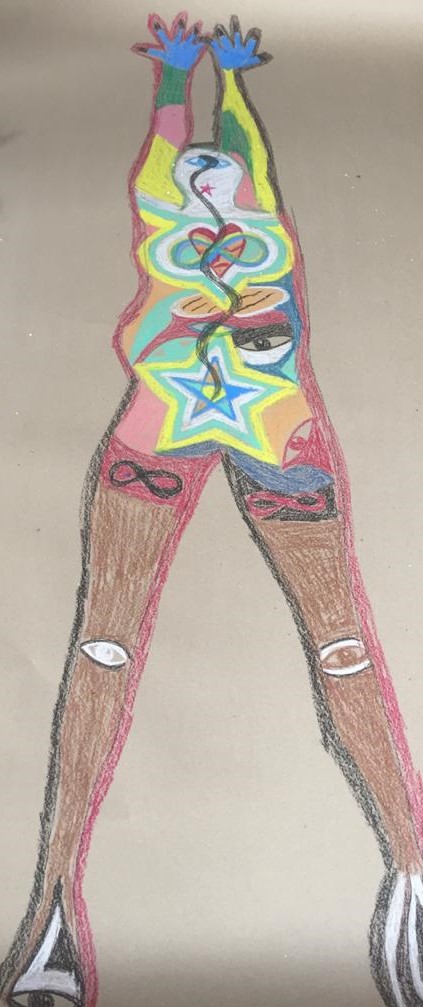Art is a constant agent of transformation and is the soul’s drive to health
Cathy Malchiodi
I would like you to join me in a small exercise.
Feel your feet on the earth and the support that the cushion/chair that you are sitting on offers you. Take a few minutes to intentionally relax and release your weight to your feet and into the cushion. Gently bring your awareness to your breath and notice how it enters and leaves your body. Now, scan your body from your feet to your head and notice any sensation that feels alive. Now notice if you are carrying any emotion/feeling. And finally be aware of any images, memories or thoughts that are coming up.
What you have just engaged in is a small exercise towards conscious embodiment. You have brought awareness to your physical, emotional and imaginal selves. By being present to and holding these different parts of yourself, you are now present in a far more holistic manner. Your listening is deeper and your empathy is far greater.

The body is our home and feeling at home in one’s own body is one of the greatest indicators of good mental health. Unfortunately in modern education, we tend to work with the physical (PE, sports) emotional (arts) and the mental (academics) separately. The mental/cognitive is also prioritised over the other two. We are taught to imagine that we ‘have’ bodies and not that we ‘are’ bodies. As a result, the body is often ignored which leaves the individual disconnected from their sensations and emotions.
When we are disconnected from our bodies, not only are we distanced from the wisdom of our body but we view our bodies as objects. This can have serious ramifications as we tend to objectify other bodies as well. For example, it is said that Rene Descartes, one of the philosophical fathers of modern science who gave us the famous ‘I think, therefore I am’, dissected a dog alive, and paid no attention to its cries. He didn’t bother with any anaesthesia for the animal; it was, to his mind, merely a machine. It had no soul, no real spirit. Similarly, a lot of the horrors we witness around us is a result of severing the connection between the body, mind and soul (spirit).
Being at home in our body makes us alive to the interconnectedness between all creatures and to our larger home, the Earth. We then no longer see the Earth as an unending resource to be used to satisfy our ever-growing needs, but rather as a living, breathing being that requires nurture and love. For in the well being of the Earth is our wellbeing and vice versa, as we are all part of the same ecosystem.
Hence, it is vitally important that in the education of every child, they deeply experience and understand this rich interaction and connection between the human race, other living beings and mother Earth. For this, we must be invested in the holistic development of the child and provide enough opportunities where the physical, emotional, imaginal and intellectual aspects of the child are brought together. This not only furthers alignment and well being, but it is possible for the child to witness the interrelation between the different parts of their psyche and make changes in one to affect changes in the other. Movement-based expressive arts is especially useful in bringing together these different sides of us.
Expressive Arts is a multimodal approach to therapy/learning and can be a vehicle for social, emotional, mental and physical development. It interweaves art modalities of dance, drama, visual arts and writing, along with creative processes, offering an integrated and holistic approach to explore our logical, emotional and imaginal selves. Movement-based expressive arts has a holistic educational value that affects the deep development of the human being. It is a primary tool for self-awareness and self-actualisation, which in turn facilitates ownership, empathy, responsibility and agency. It brings us back to our bodies, which allows us a greater connection to ourselves, to others around us, and to the world we live in.

Blessed is he who knows who he really is and builds a place to live there.
Rumi

Brinda Jacob-Janvrin
Author

Keya Gangoly
Curator
More Conversations
Becoming an algorithm
Royal Challengers winning the elusive trophy, children being subjected to intense violence in Palestine and everything inbetween rests in my palm and changes at the instruction of my fingertip. I live this life with all these fighting to engage with my measuring mind....
Strange Sequences
After many years a conversation abruptly reminded me of an event that took place while I was in college. I graduated with a degree in Life Sciences in the year 2007. We studied under three departments, Chemistry, Botany and Zoology from a very old institution located...
The Private Tiger
Tiger Prabhakar is a popular Kannada film actor who acted in the movies between late 70s and late 90s. He started acting in small negative roles, usually one of the villain's goons who gets beaten up by the protagonist. Tiger had worked his way up to become a lead...




0 Comments